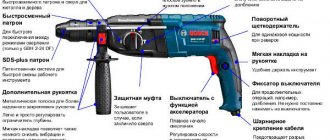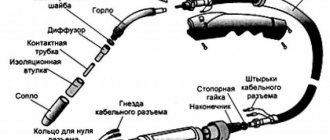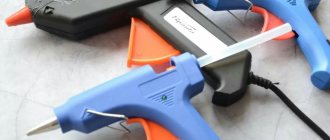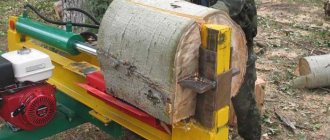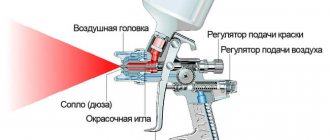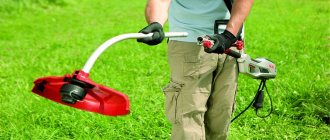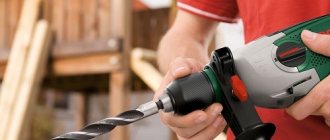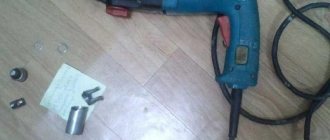The need to purchase a hammer drill always arises as soon as you plan to carry out independent repairs in a house or apartment. After choosing the appropriate model of power tool, the owner needs to learn how to use the tool. To do this, you need to find out the operating principle of the hammer drill, as well as learn the features of its use.
What is a straight hammer drill and what does it consist of?
Structurally, the instrument under consideration is of two types - pistol or straight and barrel. They differ not only externally, but also structurally. Let's look in detail at what a pistol and barrel perforator is, how they work, as well as the features of their correct use.
This is interesting!
Pistol and straight hammer drills have the same design, and they differ only in the location of the handle.
Externally, the instrument has a plastic body on which the controls are located. These organs include (for direct and pistol type hammer drills):
- Trigger for turning on the tool and regulating the speed of rotation of the executive body - the chuck
- Switch lock - allows you to prevent the tool from turning on independently, and also eliminates the need to hold the trigger, which is convenient when performing long-term work
- Reverse switch - allows you to switch the direction of rotation of the cartridge in two directions
- Regulator for switching tool operating modes
- Chuck rotation speed regulator - not available on all rotary hammer models
- Additional handle for ease of work
- The executive body is a cartridge, inside of which nozzles are fixed depending on the assigned tasks
Inside, the power tool consists of the following elements:
- The electric motor is the “heart” of the tool, which powers the chuck.
- Gear unit - rotational energy is transmitted to the gearbox, which allows you to regulate the speed and also creates an impact action. The gearbox consists of gears, as well as a special mechanism that creates impact actions
- A safety clutch is an auxiliary part that prevents tool failure when the nozzle jams in the surface being processed. If the drill jams, the electric motor may burn out.
- An anti-vibration system is a device that reduces vibrations. Such a system is relevant, since during prolonged work with a hammer drill, not only fatigue occurs, but also hand tremors. In barrel perforators this system is also more advanced compared to pistol types
These are the main internal mechanisms of a power tool, which you need to familiarize yourself with in more detail in order to understand the principle of operation of a rotary hammer. So, to find out how a hammer drill works, you need to understand the internal mechanisms.
This is interesting!
Do you know why powerful rotary hammers have a vertical engine? The reason for this is the following - the barrel hammer has an improved cooling system, as well as a reliable torque transmission mechanism.
Drum perforator repair
A barrel hammer differs from a traditional one in that the electric motor is located vertically and cannot operate in drilling mode.
Barrel hammer drill SDS-plus Intertool DT-0182
Therefore, due to the design features, in order to get to certain components, additional operations will have to be performed, in particular, to inspect the electric motor, it is necessary to remove the lower part of the casing or cover. And for replacing brushes, special technological holes are provided in the body.
Replacing brushes
To replace brushes, it is necessary to provide access to the brush assembly. To replace, you need to release the brushes from the lock and install new ones in their place.
Replacing bearings
If extraneous sounds are heard when the hammer drill is operating, then there is a high probability that the bearing has reached a certain degree of wear. That is, it needs to be replaced.
Bearing replacement
To do this, it is necessary to completely or partially disassemble the housing and gain access to the unit in which it is installed. A puller may be required to remove it. By the way, some bearings can be secured using retaining rings.
Replacing the cartridge
To replace a cartridge that has expired, you must first take into account which company produced this product. The thing is that the cartridge mounting schemes of different manufacturers have their own characteristics.
Replacing a chuck on a rotary hammer
For example, to dismantle the chuck in a Bosch rotary hammer, you need to do the following manipulations - loosen the locking ring, pull out the chuck and install a new one in its place.
Drunk bearing repair
In some models of this tool, the impact is achieved using a bearing. During intensive use, it may be destroyed.
To repair it, you will need a flathead screwdriver. After disassembling the housing, the bearing must be removed from the housing, disassembled, worn parts replaced and reinstalled.
Repair of raster bushing and impact bolt
To repair the impact mechanism of the hammer drill, it is necessary to remove the raster bushing; to do this, it is necessary to release the spring and the locking ring. After this, the impact bolt is replaced with a new one, or sent for restoration.
Replacing the sleeve
The sleeve fails quite rarely. To replace it, the old one must be removed from the aluminum case and a new one installed in its place.
What's inside the hammer drill
Structurally, the hammer drill consists of two main parts - electrical and mechanical. Depending on the location of the electric motor, rotary hammers are of direct or pistol type, as well as barrel ones. In pistol hammer drills the electric motor is located horizontally, and in barrel hammers it is located vertically.
On rotary hammers, as well as grinders, drills and other power tools, commutator electric motors are used. They consist of two main components - a stator and a rotor. The stator is a stationary part that consists of copper windings and steel plates. The stator windings create a constant electromagnetic field, which drives the rotor.
The rotor or armature is the moving part of an electric motor, which also consists of a copper winding wound on a steel core. The rotor rotates inside the stator. The rotor windings are connected to commutator plates, which are also supplied with current through graphite brushes. A slip field is created in the electric motor, which helps drive the rotor. A gear is attached to the rotor shaft, which drives the gearbox.
About safety couplings
Such devices (safety clutches) are required on all hammer drills of household, semi-professional and professional types. They are used to stop the rotation of the cartridge when the nozzle jams. If the clutch is faulty, then the following consequences may occur when jamming:
- A jammed nozzle increases the current flowing in the rotor and stator windings, which contributes to insulation melting and failure of the electric motor.
- A very powerful hammer drill can be torn out of your hands if the attachment jams, which can result in serious injury.
There are two types of safety couplings:
- The friction clutch is the most common modification of the protective mechanism, which is implemented through the use of a gear mechanism. Discs with teeth are pressed tightly against each other, transmitting rotational force. When the drill jams, the discs slip, which eliminates the occurrence of electric drive overload
- Cam or spring-claw couplings - consist of two halves with beveled projections that engage with the grooves of the mating part. These halves are called coupling halves, which are connected using springs of appropriate stiffness. As soon as a large force exceeds the spring pressure, the coupling halves disengage. When the coupling halves are disengaged, a corresponding cracking sound is formed, like on screwdrivers. This is how the ratchet works on the power tool in question. Such couplings have one significant drawback - the rolling of the protrusions, so over time the tool is used, a cracking sound occurs even when the drills do not jam. The photo below shows the essence of the rolling problem, which can be eliminated even without replacing the gear with rolled teeth (to do this, it is necessary to eliminate the rolling spots)
- Roller devices are another type of safety clutch. They are also installed in the transmission gear structure, and when the attachment becomes jammed, the transmission gear that drives the chuck begins to rotate. They are called roller due to the use of a blocking key in the form of a roller. Due to this key installed in the groove of the raster bushing, the gear is engaged and rotational force is transmitted. When the load increases (when the nozzle jams), under the action of the spring force, the gear moves along the axis of the barrel, thereby engaging with the locking teeth (blockade) located on the hammer body (on the inside). Once the drill moves freely again, the spring force is reduced and the gear returns to its original position
The photo below shows the details of the hammer drill, as well as the gearbox with an installed roller clutch. To find out which clutch is installed on the hammer drill, you will need to disassemble it. In addition, there are also magnetic couplings, but they are not used on low- and medium-power rotary hammers.
About impact mechanisms
In the design of the power tools under consideration, two types of impact mechanisms are used:
- Electromechanical
- Electropneumatic
Electro-pneumatic devices are very popular, but electromechanical ones are no longer used. They are based on a driven bearing that drives a piston. The piston moves in a raster bushing, where compressed air pressure is created. This air acts on the striker, which moves from the piston to the heel of the installed nozzle in the hammer drill chuck.
Cartridges for rotary hammers
Structurally, rotary hammers use two main types of cartridges - SDS-plus and SDS-max. There are other types, but these two types of executive bodies are considered the most popular and effective. SDS-plus is used on household and semi-professional units, and SDS-max on professional hammer drills.
The only thing that should be noted in the material is that the attachments in such chucks are not fixed rigidly, as in collet chucks. The nozzle installed in the chuck has free movement, which plays an important role for the impact mechanism. It is due to this stroke that impacts are made on the surface being treated.
Fixation of the nozzles is ensured by slots, the number of which is two in SDS-plus cartridges, and three in SDS-max devices. These splines act as guides and also allow the drill bits to rotate with the chuck. In addition to slots, the design of the devices includes balls (in SDS-plus cartridges) and rollers (SDS-max). They engage with grooves in the design of the nozzle shanks. It is due to the balls and rollers that the movable fixation of the attachments is ensured.
So, having understood the design of a power tool, it’s time to move on to the question of how a hammer drill works. The principle of its operation is simple, but it is impossible to understand it without disassembling the power tool. To do this, you will need to disassemble the tool and examine the component parts. To avoid having to disassemble the hammer drill, let’s find out how it works using a photo description.
Types of rotary hammers by weight and purpose
Based on weight and purpose, the following groups of devices are distinguished:
Light (household) rotary hammers – 2-4 kg.
Medium (semi-professional) rotary hammers – 5-8 kg.
Heavy (professional) rotary hammers – 8-10 kg.
Household hammer drills
Rotary hammers weighing less than 4 kg are considered light. They are purchased for periodic repair work at home or in the garage. Better known as “household hammer drills”.
Semi-professional hammer drills
The middle class includes semi-professional instruments weighing from 5 to 8 kg; they are distinguished by increased power and impact force (5-7 J). The tool can even cut through a steel grating, not to mention making an opening in a concrete wall.
Professional rotary hammers
The heavy class includes hammer drills weighing over 8 kg and an impact force of more than 8 J. The tool is designed for long-term, continuous operation. It is usually used by repair teams, which is why it is called professional. Buying a heavy hammer drill for domestic use is an unjustified investment.
How does a straight hammer drill work?
The operating principle of a rotary hammer is based on the conversion of electrical energy into mechanical energy. The electric motor is driven by supplying current from a 220V household network. The engine rotates the rotor, which drives the gearbox. The gearbox transmits force to the power tool chuck, in which the corresponding attachment is fixed. This is a brief description of the operating principle of a rotary hammer. When repairing or replacing parts of the power tool in question, it is not possible to understand the details of the operating principle of the device:
- First, you need to secure the working attachment in the tool chuck, which is quite simple. With one hand you need to press the plastic sleeve of the chuck against the body, and then insert the drill into the device. Do not forget to lubricate the shanks of the attachments before installing them in the chuck of the power tool.
- The plug is accordingly inserted into the socket, which is necessary for the operation of the electric motor.
- When you press the start button, an electric current is supplied to the stator of the electric motor, due to which an electromagnetic field is created. Current is supplied to the rotor through graphite brushes and a commutator. When current flows to the rotor, it moves under the influence of the resulting magnetic field. Two magnetic fields with different poles repel each other, which we see when a commutator electric motor operates
- The stator shaft is centered and located on bearings that allow it to rotate. Moreover, the shaft rotation reaches a speed of 27,000 rpm
- At the end of the rotor shaft there is a small helical gear, which meshes with the drive shaft transmission mechanism - a large diameter gear. Due to this, the rotation speed decreases and the torque increases. Typically, all tools have a constant gear ratio, and the speed is controlled electronically
- The shaft is a shaft on which gears and a bearing are located. A gear connected to the electric motor shaft drives the drill shaft
- A fixed bearing is attached to the shaft, as well as a small-diameter gear, which meshes with a large-diameter gear located on the axis of the raster bushing
- The impact option is implemented due to the skewed rotation of the driven bearing. The protrusion from the dead bearing (perpendicular axis) is connected to a piston or an oblong sleeve. This sleeve is located inside the raster sleeve, where its reciprocating or oscillatory movement occurs
- A cartridge case with a striker moves inside the raster sleeve or barrel. In the sleeve, where the firing pin moves, there is an air space, due to which the impact on the part occurs. The piston pumps up air pressure, thereby acting on the movable firing pin. Under the influence of compressed air pressure, the striker moves, acting with the striking part on the impact bolt or striker. The hammer serves to transfer the resulting impact force from the striker to the heel of the installed attachment in the hammer drill chuck. The stroke of the striker itself is about 3-4 mm. There is a sealing rubber on the striker, which wears out over time, which manifests itself in the form of a decrease in impact function (impact force decreases). To return the previous impact force of the tool, it is necessary to replace the rubber on the striker
- The gear from the shaft transmits force to a gear mounted on a raster bushing and located perpendicular to the shaft. The gear, which is mounted on the raster bushing and transmits the rotational force to the chuck, is designed to reduce the frequency of movement of the chuck
As a result, the hammer drill operates in hammer drilling mode. In addition to the drilling mode with impact, pistol units are also capable of drilling without impact or operating in hammer mode. To do this, the design of the power tool has a switch that turns off the rotation of the driven bearing or gear on the shaft, depending on the mode being turned on. By the way, the drilling function is turned off due to the jamming of the gear located on the raster bushing.
Power tools can be used not only for processing concrete and other durable structures, but also for processing metal, wood, plastic and glass. Knowing how a straight hammer drill works, it will not be difficult to find the cause of its malfunction, as well as eliminate it. Often, when parts of a hammer drill fail, they need to be replaced. Moreover, depending on the scale of the breakdown, it may be necessary to replace either the entire mechanism - the gearbox, or individual parts - the driven bearing, striker, gears.
The impact mechanism on a rotary hammer operates exclusively under load, so at idle, when the installed attachment is not pressed against the surface being processed, the tool will not create an impact. This is achieved due to the fact that the impact pin moves inside the raster sleeve, however, due to the lack of compression (pressure), it moves idle. As soon as the nozzle is installed in the chuck and pressed against the surface being treated, the channel is blocked in the area where the end of the shank is located, thereby creating compression. In the presence of compression, the force of the working stroke of the striker, acting on the heel of the installed nozzle, increases. This force is called impact, and is measured in Joules. In pistol hammer drills the impact force reaches 2-3 Joules, and in barrel professional models up to 20 Joules.
This is interesting!
The operating principle of a barrel-type hammer drill differs from a direct hammer drill, so we should consider how professional units work separately.
Instead of a drunken bearing, crank mechanisms are used in barrel units. The operating principle of DeWalt pistol-type rotary hammers is described above. All pistol hammer drills of the brands Interskol, Energomash, Bosch, Stern, Makita, Hilti and others operate on a similar principle.
How the tool works
Literally, the word perforator means “drill hammer.” To increase productivity in mining operations, the jackhammer was developed in the early 19th century. The principle of operation of the device was to use a flywheel. He set in motion a bar with special tucks attached to it. The rod, under the influence of a spring, struck and returned back with a piston.
The device was constantly improved. In 1932, in Germany, the Bosch Corporation released the first rotary hammer powered by electricity. This device combined impact and torque. The operating principle developed by the company is still used in modern models of electric hammer drills.
A rock drill is a device designed to drill holes and destroy hard rock. Drills of different diameters and chisels are used as consumables. The tool is divided by application class:
- domestic;
- semi-professional;
- professional.
In addition, it is distinguished by its operating mechanism, which can be electromagnetic or pneumatic. The last type of mechanism is available in one-, two-, and three-mode. That is, you can perform drilling, striking, or both operations simultaneously.
The tool resembles a pistol in appearance and can be operated with an electric, fuel or pneumatic drive. The latter are in demand under hazardous working conditions, during which there is a possibility of explosion.
The operating principle of a hammer drill, which distinguishes it from other similar tools, is based on the impact mechanism. The electromagnetic type uses two electromagnetic coils to provide reciprocating motion of the core. It transfers inertia to the drill shank. The pneumatic type is based on the movement of a piston in a cylinder, which also performs reciprocating movements.
The operation of an electric hammer drill uses the conversion of engine rotation into the shock-rotational movement of the drill. The coupling used in the design provides protection under increased loads. The drill bearing and piston create the impact force, and the drill clamp provides the chuck.
Each manufacturer strives to improve the design through the use of design features. These are mainly minor modifications related to the use of various materials and their location. In general, the main elements remain unchanged. Such details include:
- power button;
- engine;
- impact mechanism;
- safety clutch;
- drill clamp.
Additional design features include a dust removal system and a vibration suppression unit. For a multi-mode type of tool, a work switching button is installed.
How to work with a hammer drill or increase the life of the tool
Having understood the principle of operation of a hammer drill, it will not be difficult to learn how to use it correctly. To increase the service life of the tool in question, it is recommended to perform the following actions:
- Always check that the tool is working properly before starting work. If extraneous sounds or interruptions occur, it is prohibited to operate the faulty tool. This is not only life-threatening, but can also lead to failure of the entire mechanism of the tool.
- Be sure to lubricate the shanks of the nozzles that are installed in the hammer drill chuck.
- Keep the tool strictly at right angles to the surface being worked when drilling concrete
- Work exclusively in protective gear
- Do not touch the nozzle with your bare hands after finishing work, as the drills heat up to a temperature of 80-90 degrees or more
- After finishing work, you need to put the tool in a protective case.
- Work must be carried out exclusively with serviceable attachments, that is, they must be sharpened and also free from defects that during the work process could lead to the drill or lance breaking into two parts
Do not forget about periodic diagnostics of the gear unit, which needs regular lubricant replacement. Only with the right approach to using a power tool can we say that it will last not only the specified warranty period, but also five times longer than this period.
Operational safety
A rotary hammer is an electromechanical tool, so it must be used while observing safety precautions.
- Before starting work, you need to make sure that the electrical cord is intact. A damaged plug or insulation on the cord may cause electric shock. Cracks in the housing can also be a source of danger.
- Replacement attachments must be securely fastened, otherwise they may jump out of the chuck during operation and cause injury.
- It is necessary to drill the material without touching the rotating part of the tool: sharp edges easily damage hands and other parts of the body.
- The attachments become very hot when rotating, so after finishing work you should not touch them with bare hands to avoid burns.
Operating power tools correctly means maintaining your health. Be sure to follow safety rules and wear personal protective equipment: gloves, a mask or goggles, and special work clothes.
